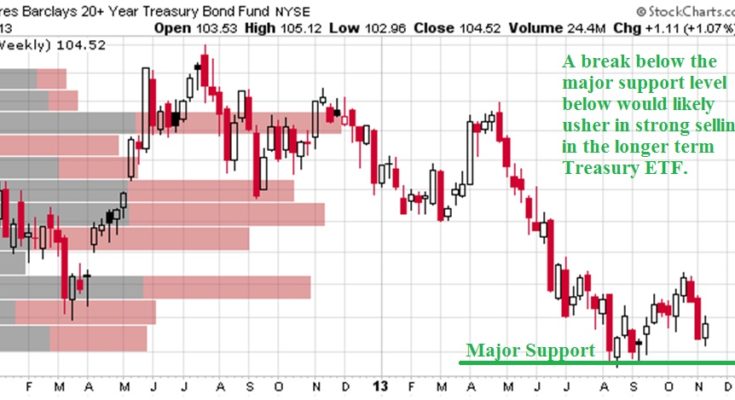The incredible rally in equities in 2013 has begun to stir concern among many that the stock market is now in a bubble. We have entered the euphoric stage of this bull market and equity prices cannot and will not go lower according to some talking heads in the financial punditry.
While chatter is starting to heat up that equities are in a bubble, the real bubble seems to be ignored for the most part. The larger, more concerning bubble is in the Treasury marketplace where the Federal Reserve continues to print money to purchase treasury bonds to help keep interest rates artificially low.
Instead of debating the bubbles in Treasury’s versus equities, or trying to predict when the bubble in either asset class may pop, I will focus on the near term for price action expectations in longer-dated Treasury bonds.
Below is a weekly chart of the Treasury ETF TLT which reflects the price action and yield generation of a portfolio of 20+ year duration Treasury bonds issued by the U.S. federal government.

I have identified the key support areas which are supported by the price by volume indicator as well. Not many seem interested in discussing the nearly 13% drop year-to-date we have seen in longer-dated Treasury bonds shown above.
Furthermore, based on current price action we could see lower lows in the days and weeks ahead if price breaks below near-term support levels around $102.20 / share. Let’s look into the future from an option trader’s perspective.
Based on the bill which was recently passed to reopen the government, there are two key dates which could impact Treasury bonds. The recently passed bill keeps the government open until January 15, 2014 at which point Congress will either compromise on a budget or accept additional sequester cuts. If no compromise is reached and the sequester cuts are not favored, the federal government could shut down again.
The other key date is February 7 which is the date that Congress will hit the debt ceiling. It is likely that through special measures the Treasury can push that date beyond February. However, the debt ceiling discussion will again impact government bonds as the threat of another default will likely emerge.

